- Vector Library
- Upload Vector Logo

The Kenya Medical Research Institute is a medical research centre in East Africa. It is located in Kenya's capital, Nairobi. Established in 1979, KEMRI has played an important role in the fight against malaria, HIV/AIDS, and other diseases in Kenya and Sub-Saharan Africa as a whole
Download the vector logo of the KEMRI brand designed by Josphat Kimani in Scalable Vector Graphics (SVG) format. The current status of the logo is active, which means the logo is currently in use.
Downloading this artwork you agree to the following:
The above logo design and the artwork you are about to download is the intellectual property of the copyright and/or trademark holder and is offered to you as a convenience for lawful use with proper permission from the copyright and/or trademark holder only. You hereby agree that you agree to the Terms of Use and that the artwork you download will be used for non-commercial use without infringing on the rights of the copyright and/or trademark holder and in compliance with the DMCA act of 1998. Before you use or reproduce this artwork in any manner, you agree to obtain the express permission of the copyright and/or trademark holder. Failure to obtain such permission is a violation of international copyright and trademark laws subject to specific financial and criminal penalties.

The Kenya Medical Research Institute is a medical research centre in East Africa. It is located in Kenya's capital, Nairobi. Established in 1979, KEMRI has played an important role in the fight against malaria, HIV/AIDS, and other diseases in Kenya and Sub-Saharan Africa as a whole


About KEMRI Logo
The KEMRI logo is a health and medical logo made up of around 5 different colors.
The KEMRI logo contains a number of different shapes, including 2 squares, 2 rectangles, 11 stars and 38 circles.
The KEMRI logo is made up of a bunch of different colors. These colors include aqua, red, maroon, black and silver. Beyond those 5 basic colors there are also 5 more specific colors found, these include turquoise blue, tomato, reddy brown, black and blush.
The KEMRI logo is a Health And Medical and Kenya logo.
You can read more about KEMRI on their website .
Basic Colors
We've taken a look at the image and pulled out some colors that are common across lots of logos. The colors below aren't the exact colors found in the image, but approximations to common colors.
Advanced Colors
We've extracted the below 'advanced colors' from the logo. These should be much closer to the actual colors found in the logo. Our extractor tries to only take the main colors of the image and tries to ignore shading on anti-aliasing or shadows. This generally leads to better results, but in some circumstances you might find a few unusual colors being pulled from the logo.
The below are the hex colors that are found in the logo. You can assume that these are the actual colors used in the logo. Our color extraction tool that takes the colors from the logo tries to ignore anti-aliasing and shadows, so you may sometimes find a slightly odd result, but this is rare. These colors should be very similar to the Advanced Colors, but you'll notice subtle differences. If you're interested in the exact color then use the hex, but if you're trying to describe the logo then use the Advanced Color or the Basic Color above.
Similar Logos
The following logos are similar to this logo.

Smile Logo For Dentist

eyes doctor
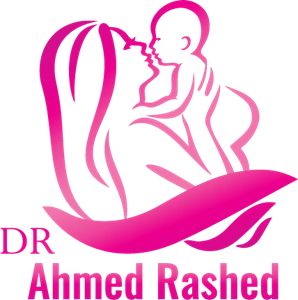
pregnancy logo

PLAN ASSISTE

PRÓ SAÚDE TJDFT

LEYLA&EYLÜL/türkiye_gündemi
- Celebrities
- Beauty & Health
- Food, Travel, Arts & Culture
- International
- Pulse Influencer Awards
Meaning of snakes on KMTC, KNH & other medical logos in Kenya
When you visit a doctor’s office or a pharmacy, you often encounter a familiar symbol: a staff with a snake coiled around it.
This emblem, known as the Rod of Asclepius, is a staple in medical logos worldwide.
Yet, alongside it, another symbol frequently appears – the Caduceus, featuring two snakes winding around a winged staff.
Despite their widespread use, these symbols are shrouded in confusion and historical mix-ups.
More specifically in Kenya, snakes can be found in logos of institutions like Kenya Medical Training College , Kenyatta National Hospital , Moi Teaching & Referral Hospital, Kenya Medical Research Institute, Kenya Medical Association, the World Health Organisation and many more.
Why do these snake-laden icons dominate the logos of so many medical organizations?
This article highlights into the intriguing origins and meanings of snake imagery in healthcare branding, shedding light on a centuries-old tradition that continues to influence modern medicine.
Historical Origins
The connection between snakes and medicine is as ancient as it is profound, with roots deeply embedded in myth and tradition. Central to this historical relationship is Asclepius, the Greek god of healing and medicine, whose primary symbol was a staff entwined by a single serpent.
This emblem, known today as the Rod of Asclepius, originated from a legend in which Asclepius, possessing vast medical knowledge and healing powers, used a staff to perform miracles.
One such tale recounts how Asclepius brought a patient back from the brink of death using a herb shown to him by a serpent, reinforcing the snake's role as a benefactor in medicine.
What do snakes symbolise?
In many cultures, snakes are seen as symbols of rejuvenation and immortality, often attributed to their ability to shed their skin and emerge anew.
Similar motifs appear in other cultures, suggesting a universal reverence for the snake as a symbol of life, death, and rebirth.
For instance, in ancient Egyptian culture, the serpent was associated with Wadjet, a goddess of protection and healing, often depicted as a cobra—a symbol that pharaohs wore on their crowns as protectors of their health and power.
Beyond rejuvenation, snakes were often associated with immortality and wisdom in numerous cultural myths.
READ: 'It tastes like chicken' — Hollywood star Lupita Nyong'o eats snake meat in Benin
In Hindu mythology, the snake is connected to Lord Shiva, who wears a cobra around his neck as a symbol of control over death and fear, reinforcing the snake's association with immortality and the profound knowledge of life's cycles.
Wisdom is another attribute commonly associated with snakes, influenced by their cautious and calculated movements.
In many traditions, snakes are considered wise due to their discreet and deliberate actions. In the medical context, this symbolizes the deliberate and thoughtful approach that healthcare professionals must take when caring for patients.
The wisdom of the snake emphasizes the importance of knowledge, precision, and ethical responsibility in medicine.
Modern Usage and Variations
Today, the imagery of the snake continues to be a dominant symbol in the branding of medical organizations, but it appears in slightly varied forms that carry distinct historical and symbolic meanings.
The two primary symbols incorporating snakes are the Rod of Asclepius and the Caduceus, each representing different aspects of healthcare and medicine.
The Rod of Asclepius, consisting of a single snake wrapped around a staff, is the more traditional symbol associated with medicine and healing.
It is widely used by medical professionals, hospitals, and healthcare organizations .
This symbol directly emphasises the sole focus on healthcare and the therapeutic relationship between caregiver and patient. Its simplicity and direct connection to healing make it a powerful symbol for those directly involved in medical care.
The Caduceus, featuring two snakes intertwined around a winged staff, is often confused with the Rod of Asclepius but has a different origin and connotation.
Historically linked to Hermes, the Greek god of commerce, heralds, and trade, the Caduceus symbolizes negotiation and reciprocity. Its adoption in medical contexts often stems from historical misinterpretations.
According to the University of Florida College of Medicine, the caduceus came to be associated with a precursor of medicine in the seventh century, based on the Hermetic astrological principles of using the planets and stars to heal the sick.
However, it has come to be associated with various aspects of healthcare that deal with administrative, logistical, and clerical aspects of health services.
Differences between the Rod of Asclepius and The Caduceus
The distinction between these symbols is significant in understanding the varied facets of health services today.
While the Rod of Asclepius highlights the healing and clinical side of medicine, the Caduceus can represent the broader organizational and operational aspects of healthcare institutions.
This differentiation helps various medical entities align their branding with specific roles and functions within the larger healthcare ecosystem, whether they are directly involved in patient care or in supporting administrative functions that facilitate healthcare delivery.
In modern branding, these symbols not only signify the heritage and ethos of medical professions but also help differentiate the services and roles within complex healthcare systems, catering to a broad spectrum of needs and functions.
As we navigate the complexities of modern medicine, these ancient symbols serve not only as a bridge to our historical past but also as a reminder of the timeless principles that govern the field of healthcare.
They reflect the ongoing commitment to patient care, the pursuit of medical knowledge, and the ethical standards that are as relevant today as they were in ancient times.
As we consider the impact of these symbols, we invite you to share your thoughts. Do you think the historical and symbolic meanings of the snake still resonate in today’s medical world?
How does your local medical community represent these ancient symbols in their practices?
This content was created with the help of an AI model and verified by the writer. (50% AI, 50% writer)
Recommended articles
Join our pulse community.
Welcome to the Pulse Community! We will now be sending you a daily newsletter on news, entertainment and more. Also join us across all of our other channels - we love to be connected!
Eyewitness? Submit your stories now via social or:
Email: [email protected]
10 benefits mums get by properly spacing children
Karen nyamu’s cryptic message after ruto addressed her conduct in public, legendary gospel singer jemimah thiong'o appeals for financial assistance, 8 reasons ringworms keep attacking your child, heels & manicured nails - frankie justgymit defends new fashion choices, 10 ways neighbours can help each other stay warm during cold seasons, 9 benefits that come with renting a house compared to owning one, 8 business ideas to adopt during the july-august cold season, escape the chill: 10 indoor date ideas to beat july cold.
The Vanguard Lounge in Nairobi closes, 1 year after grand opening
3 don'ts when attending to a bullet wound [Video]
Kemri ranked the third best research agency in Africa
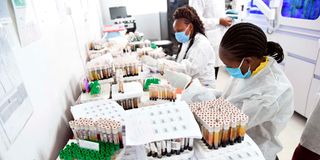
Laboratory technologists working on HIV sample tests at Kenya Medical Research Institute on April 7, 2020.

By Leon Lidigu
Health Reporter
Nation Media Group
What you need to know:
- Kemri ranked third on the continent out of 352 institutions.
South African Medical Research Council topped the list while Mozambique’s Centro de Investigacao em Saude da Manhica came in second.
The Kenya Medical Research Institute (Kemri) has been named the third best health research institution in Africa in terms of health research output; and the best in Kenya by the authoritative global information analytics giant, Scimago Lab.
According to the just released 2023 rankings by Scamigo in conjunction with Elsevier, a technologically based company offering innovative solutions to improve scientific visibility and online reputation, Kemri ranked third on the continent out of 352 institutions.
Reacting to the announcement, the Kenya Medical Research Institute Director-General Elijah Songok expressed his gratitude to the Kemri fraternity.
“First, I want to thank the Board of Directors for providing the institute with leadership; and second the members of staff for working tirelessly in ensuring the dissemination of health research is done effectively. As an institute, we are keen on further improving human health research through innovation not only in the country but also globally.”
Scamigo Lab operates Scimago Institutions Rankings (SIR), a classification of academic and research related institutions ranked by a composite indicator that combines different sets of indicators based on research performance, innovation outputs and societal impact.
The ranking is divided into five sectors: government, health, higher education, private and others. For each, it measures areas such as research output, international collaboration, normalised impact and publication rate.
Kemri has continued to perform well in the SIR classifications for the past four years.
In 2019, Kemri was ranked the top research institution both in the country and in Africa.
According to Scamigo,SIR reviews every dimension of the scholarly communication carried out at an organisation, providing valuable information about research performance, efficiency and effectiveness of the institution’s research policies and programmes. In addition, the SIR provides a friendly interface that allows the visualisation of any customised ranking from the combination of sets of indicators and compares the trends before arriving at a conclusion.
“The SIR includes both size-dependent and size independent indicators; that is indicators influenced and not influenced by the size of the institutions. In this manner, the SIR provides overall statistics of the scientific publication and other output of institutions, which enables comparisons between institutions of different sizes.
Some of the score indicators are Research Factor, Normalized Impact, Excellence with Leadership Output, Scientific Leadership, High Quality Publications and International Collaboration. Others are Knowledge Patents, Technological Impact and Societal Factor.
[email protected]
Editor's picks
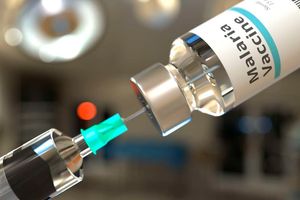
Kenya helps world get second malaria vaccine
The R21 vaccine was shown to reduce symptomatic cases of malaria by 75 per cent.
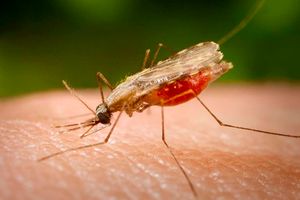
WHO approves second malaria jab for children, to cost as low as Sh300
The drug which was tested in three other African countries, becomes the world’s second vaccine to be added to the global prequalified list.
In the headlines

PREMIUM Day Parliament was raided
Members of Parliament say they saw death and knew it was the end of the road for them.

Ruto assents to IEBC Bill 2024
Opposition leaders Raila Odinga and Kalonzo Musyoka attend the signing ceremony.

PREMIUM Isolating Gachagua: His Mathira MP ‘son’ latest to ditch him
Mathira MP is the latest leader in Mt Kenya to bolt out of the Deputy President's camp.
Cookies on this website
We use cookies to ensure that we give you the best experience on our website. If you click 'Accept all cookies' we'll assume that you are happy to receive all cookies and you won't see this message again. If you click 'Reject all non-essential cookies' only necessary cookies providing core functionality such as security, network management, and accessibility will be enabled. Click 'Find out more' for information on how to change your cookie settings.

- Accessibility
KWTRP KEMRI-Wellcome Trust Research Programme
- +254 730 162110 / + 254 730 162 000
- [email protected]
- http://kemri-wellcome.org/
Established in 1989
Over 100 researchers
The KEMRI-Wellcome Trust Research Programme is a partnership between the Kenya Medical Research Institute, the Wellcome Trust and the University of Oxford. The Programme has grown from a small group to a facility hosting over 100 research scientists and 700 support staff working across Kenya, Uganda and the region.

KEMRI-Wellcome Trust Collaborative Research Programme
The Kenya Medical Research Institute (KEMRI) - Wellcome Trust Research Programme (KWTRP) was formally established in 1989 as a partnership between KEMRI (Kenya Medical Research Institute), Oxford University and Wellcome. We aim to expand the country’s capacity to conduct multidisciplinary research that is strong, sustainable and internationally competitive. Strong community links are at the heart of the Programme, with an emphasis on capacity building and training to build scientific leadership.
Several key principles run through our work:
- to carry out research to the highest scientific and ethical standards on major causes of morbidity and mortality in Africa
- to build strong and sustainable internationally competitive, national and regional research capacity
- to work in a way that facilitates integration and cross-fertilisation of scientific disciplines, from basic biology, clinical and operational research to social science
- to have a direct input into local and international health policy.
The KWTRP includes three hubs, with the main hub in coastal Kilifi, an hour’s drive from Kenya’s second largest city, Mombasa. The Kilifi hub is based in the main County Referral Hospital, serving over half a million residents and linking basic studies with molecular laboratories to clinical applications with local relevance.
In Nairobi, the KWTRP hub has strong links with the Ministry of Health, with a number of researchers actively providing advice to policy-makers. Work is carried out in multiple locations across Kenya in collaboration with a number of bilateral and national partners and academic institutions, including the University of Nairobi and Strathmore University. Nairobi also serves as a hub for work conducted in partnership with many countries in Africa and more recently in WHO’s Eastern Mediterranean region.
The KWTRP is supporting the development of infrastructural capacity in Eastern Uganda in partnership with the Mbale and Soroti Regional Referral Hospitals. This work is focusing on malaria and its consequences in the region – direct morbidity and mortality and the indirect consequences of malaria including bacterial infection, malnutrition and genetic polymorphisms.
KWTRP hosts the Initiative to Develop African Research Leaders ( IDeAL ), a training programme designed to develop young African scientists into world-class research leaders. IDeAL aims to keep scientists at African institutions through a defined programme of recruitment, supervision, mentorship, multidisciplinary approaches and clear career paths.
The KWTRP is acting as a centre of excellence where promising African researchers can work within a strong scientific environment, forging their own links with the international scientific community.
Latest news
KWTRP Annual Policy Engagement Forum
20 June 2024
Associate Professors 2024
17 May 2024
Improving pneumonia recovery in malnourished African children
Research highlights.
Tungiasis among children in Kenya is associated with poor nutrition status, absenteeism, poor school performance and high impact on quality of life
Nutritional supplementation in children with severe pneumonia in Uganda and Kenya (COAST-Nutrition): a phase 2 randomised controlled trial
Characterising support and care assistants in formal hospital settings: a scoping review
KWTRP NDM-CGHR
Article title
Article date.
Article description
Kenya Medical Research Institute

Kenya Medical Research Institute (KEMRI) is a State Corporation established through the Science and Technology (Amendment) Act of 1979, which has since been amended to Science, Technology and Innovation Act 2013. The 1979 Act established KEMRI as a National body responsible for carrying out health research in Kenya.
- Visit kemri.org
- Are you an expert from this institution? Register to write
- Article Feed
Displaying 1 - 20 of 36 articles

Le choléra peut vous tuer en quelques heures s'il n'est pas traité : comment reconnaître les symptômes et vous protéger
Samuel Kariuki , Kenya Medical Research Institute

Cholera can kill you within hours if left untreated: how to recognise the symptoms and protect yourself

Neglected tropical diseases persist in the world’s poorest places: four reads about hurdles and progress
Nadine Dreyer , The Conversation
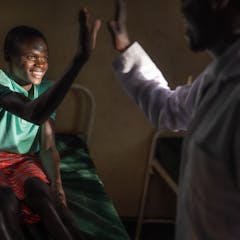
Eliminating neglected diseases in Africa: there are good reasons for hope
Monique Wasunna , Kenya Medical Research Institute
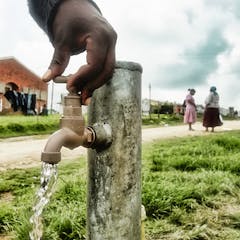
Why cholera continues to threaten many African countries
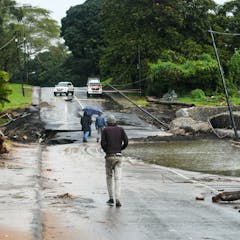
How climate change influences the spread of disease – four essential reads
Moina Spooner , The Conversation and Ina Skosana, The Conversation
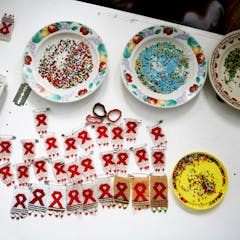
The people most at risk of HIV in Kenya aren’t using preventive drugs: we asked why
Makobu Kimani , Kenya Medical Research Institute
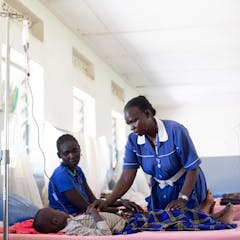

Progress against a neglected tropical disease in east Africa is under threat
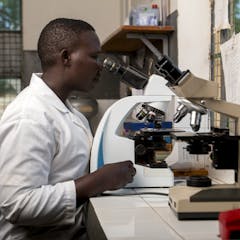
Innovation – and research – are key to killing off neglected tropical diseases in Africa
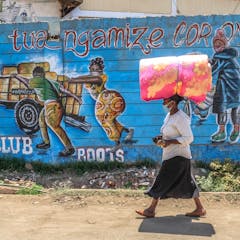
Strong leadership fought COVID-19 in Africa: the next step is to harness research

How the Spanish flu affected Kenya – and its similarities to coronavirus
Fred Andayi , Kenya Medical Research Institute

Why the elimination of malaria needs much greater involvement of women
Damaris Matoke-Muhia , Kenya Medical Research Institute
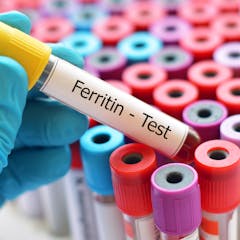
The way we measure iron deficiency in children needs to change. Here’s why
Dr John Muthii Muriuki , Kenya Medical Research Institute
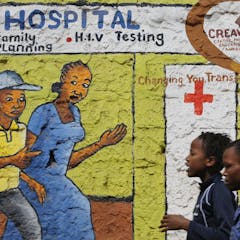
HIV in Kenya: high risk groups aren’t getting the attention they need

What mapping Kenya’s child deaths for 50 years revealed – and why it matters
Peter Macharia , Kenya Medical Research Institute and Emelda Okiro , Kenya Medical Research Institute
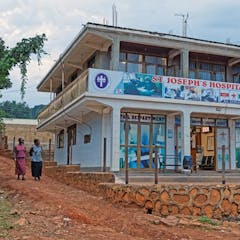
África: algunas soluciones para aminorar el largo camino al hospital
Paul Ouma , Kenya Medical Research Institute and Emelda Okiro , Kenya Medical Research Institute
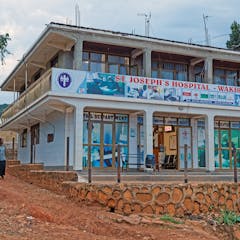
People across Africa have to travel far to get to a hospital. We worked out how far
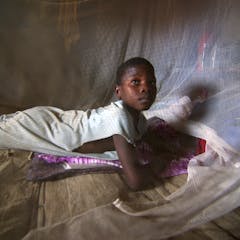
Malaria control strategies reduce the caseload - but bring new challenges
Andrew Githeko , Kenya Medical Research Institute and Ednah Ototo , Kenya Medical Research Institute
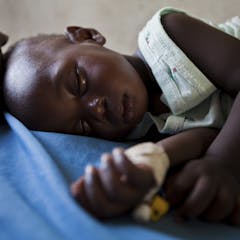
Prompt response to malaria outbreak is critical as risk of disease spreads
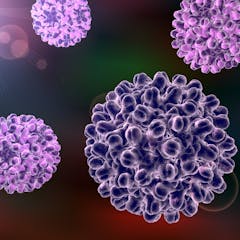
Mapping hepatitis in Kenya shows where action is needed
Ochwoto Missiani , Kenya Medical Research Institute ; Julius Oyugi , University of Nairobi , and Simeon Mining , Moi University
Chief Research Officer, Kenya Medical Research Institute
Senior Research scientist, Kenya Medical Research Institute
Research fellow, Kenya Medical Research Institute
PhD Candidate , Medical Parasitologist, Kenya Medical Research Institute
Head, Population Health Unit, KEMRI, Kenya Medical Research Institute
Research Associate, Kenya Medical Research Institute
Head of Department, Production, Kenya Medical Research Institute
Public Health Specialist, Senior Research Scientist, Kenya Medical Research Institute
Post-doctoral researcher, KEMRI-Wellcome Trust Research Program, Kenya Medical Research Institute
Researcher, Kenya Medical Research Institute
Research Officer, Kenya Medical Research Institute
PhD Fellow, Kenya Medical Research Institute
Director DNDi Eastern Africa and Senior Principal Research Scientist, KEMRI, Kenya Medical Research Institute
Chief Research Officer, Malaria Branch Chief in the KEMRI, CDC and London School of Tropical Medicine Collaborative Program, Kenya Medical Research Institute
Postdoctoral research student, KEMRI-Wellcome Trust Research Programme, Kenya Medical Research Institute
More Authors
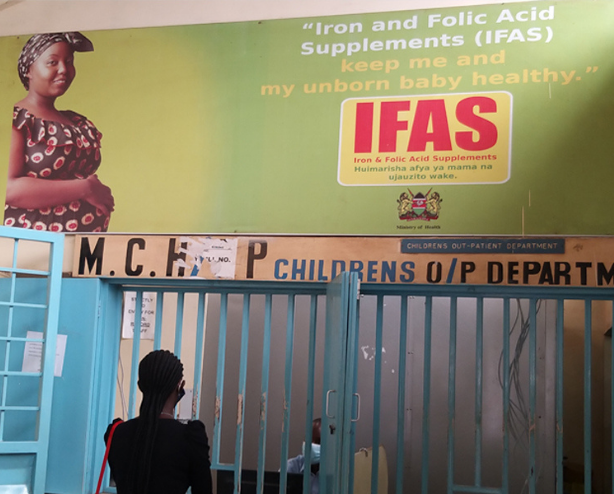
HJFMRI Receives Grant from the Bill & Melinda Gates Foundation
HJFMRI was awarded $1.3M by the Bill & Melinda Gates Foundation to support cutting-edge research on COVID-19's impact on antenatal, intrapartum and postnatal care in Kenya.
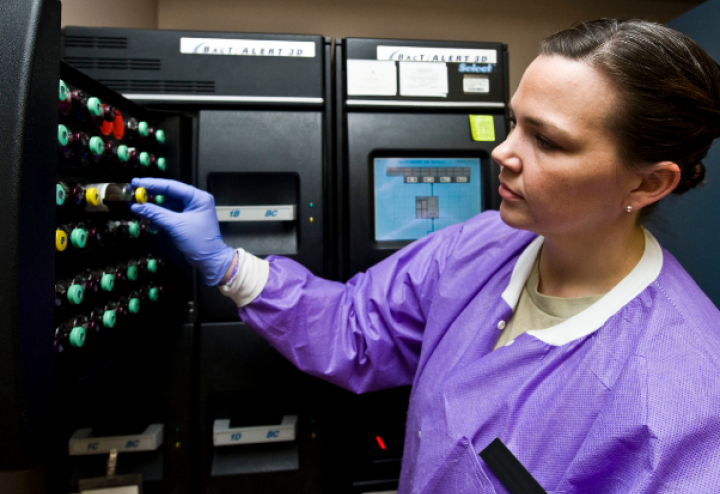
Fighting Sepsis in Austere Environments
Since 2013 HJF has served as an integrating coordinator for the Austere environments Consortium for Enhanced Sepsis Outcomes (ACESO), which is an established consortium consisting of government, non-profit, university, and industry partners dedicated to improving survival for patients with sepsis.
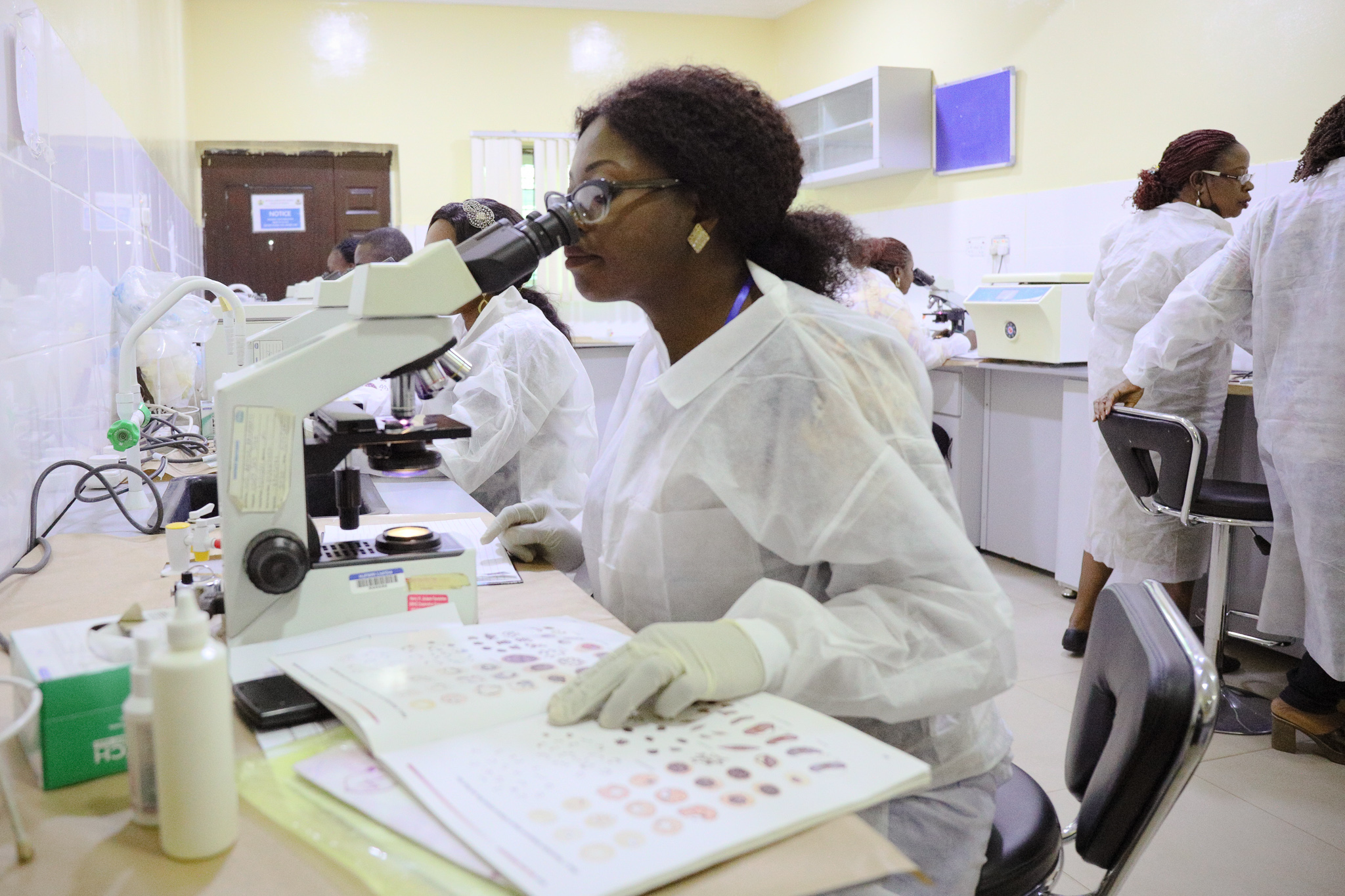
Preparing for Infectious Disease Outbreak
For 20 years, HJFMRI has been a global leader in international medical research programs related to infectious disease. Our team leverages its existing global infrastructure to better understand, treat and prevent infectious diseases.
Growing HJFMRI Impact
Founded in 2020 in Kisumu, Kenya, the HJFMRI Western Kenya Office has been able to pursue new opportunities and attract new grants from existing partners due to increased client satisfaction and improved service delivery.
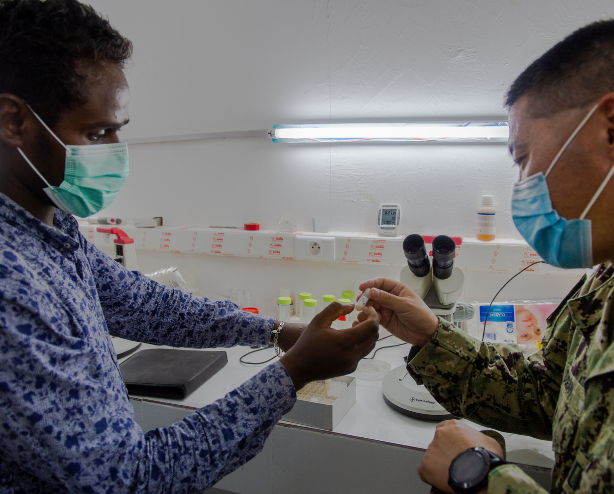
Collaborating with CAMRIS
HJF, of which HJFMRI is a subsidiary, acquired CAMRIS International LLC, in October 2020. HJFMRI closely collaborates with CAMRIS International LLC. CAMRIS has supported dozens of government programs over the past 20 years focused on medical research and public health, including many programs overseas and has capacity to quickly start up efforts in new countries within months.

In Search of a Malaria Vaccine Despite the COVID-19 Pandemic
HJFMRI is committed to supporting KEMRI/CDC efforts to create a malaria vaccine. To prevent the COVID-19 pandemic from completely disrupting the study, the HJFMRI team developed innovative and efficient methods to support the clinical trial by ensuring day to day running of the study.
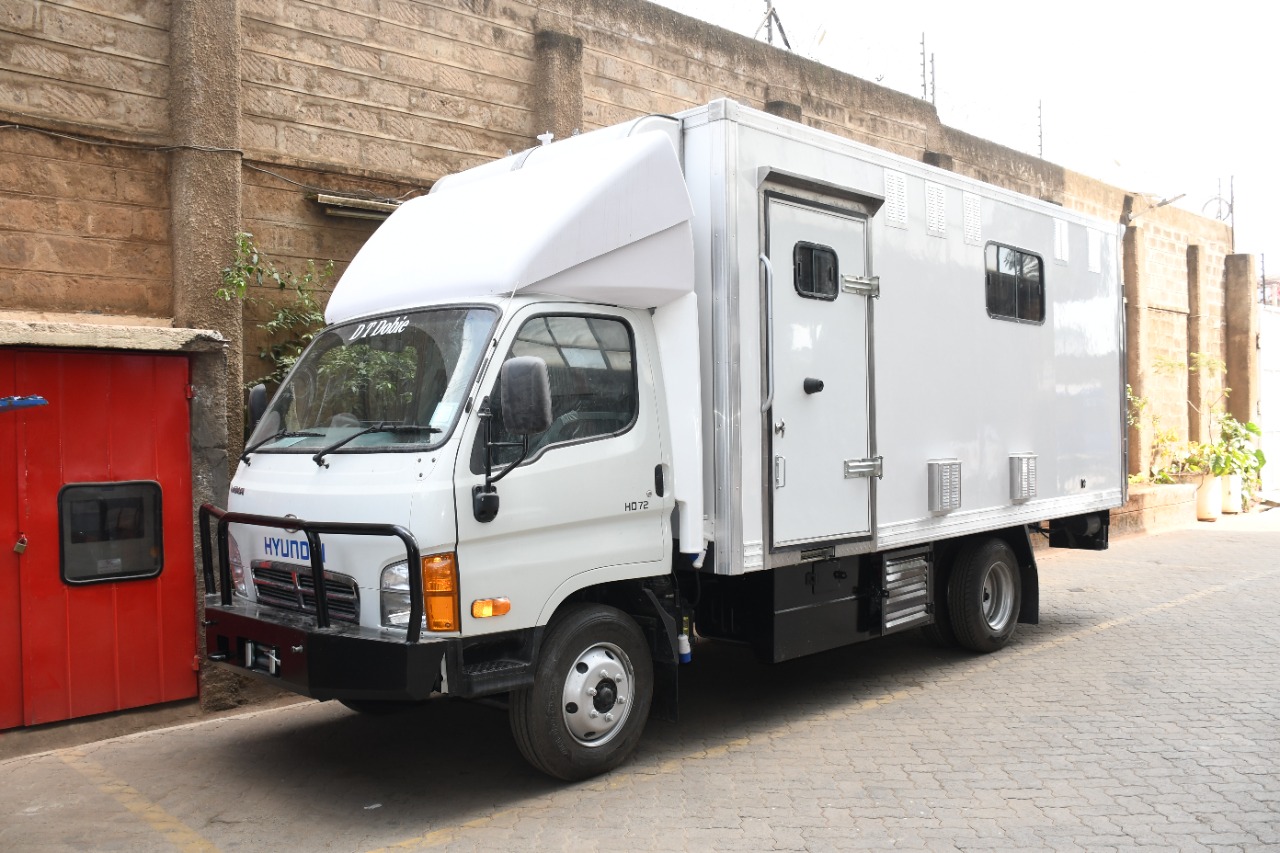
Mobile Mortuary
The HJFMRI team in Nairobi, Kenya successfully coordinated stakeholders and teammates alike in designing, procuring and equipping a mobile mortuary that is a first of the kind in the country and most likely the only one in the region.
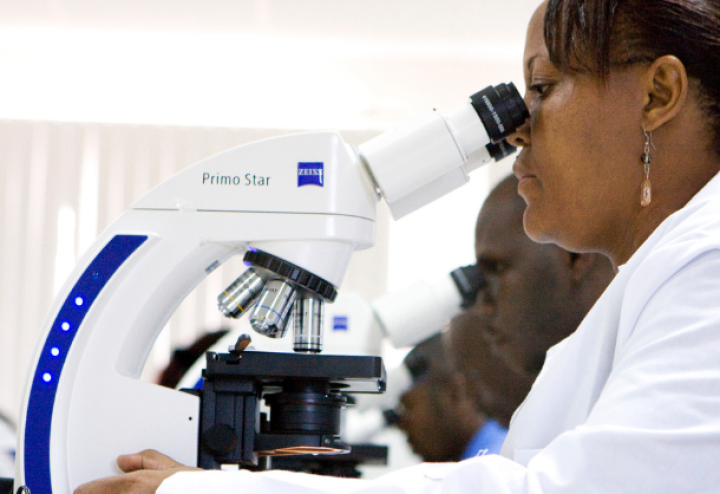
First Lab in Kenya Accredited by the College of American Pathologists
The Kericho Clinical Research Center’s lab, staffed jointly by HJFMRI and the Kenya Medical Research Institute (KEMRI), was the first in Kenya to be accredited by the College of American Pathologists.
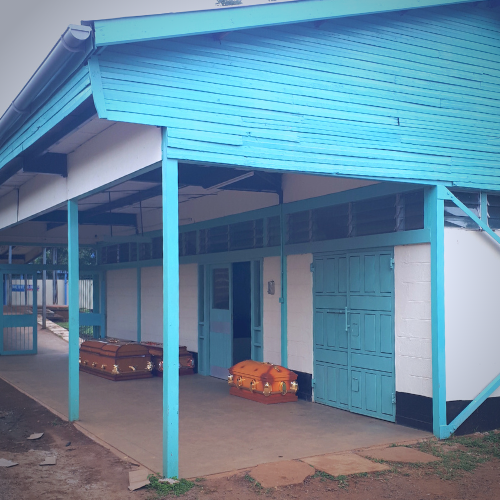
Siaya Morgue Renovation
In April 2021 the HJFMRI team provided technical guidance on the renovation of the Siaya County Referral Hospital. The HJFMRI team supervised the entire project to completion, and now that the facility is completed, MITS procedures are being conducted with greater ease and efficiency.
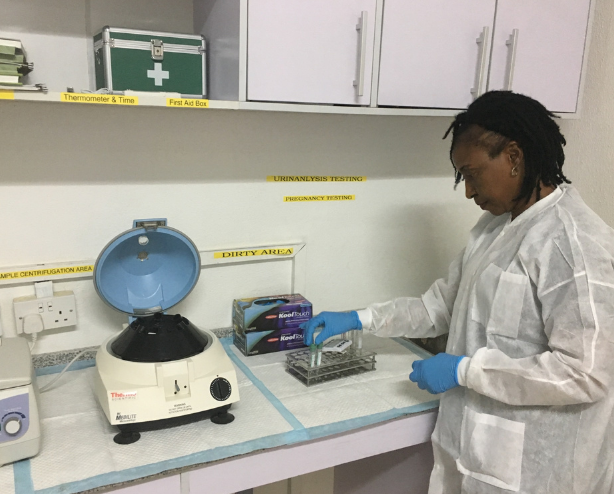
Building Sustainable Clinical Research Infrastructure
HJFMRI LTD GTE helped stand up a new Clinical Research Center in Abuja, Nigeria with the Walter Reed Army Institute of Research (WRAIR) to conduct clinical trials to combat infectious diseases. The CRC in Abuja conducts HIV studies and has pivoted to combat emerging health threats such as Ebola, Lassa fever and COVID-19.
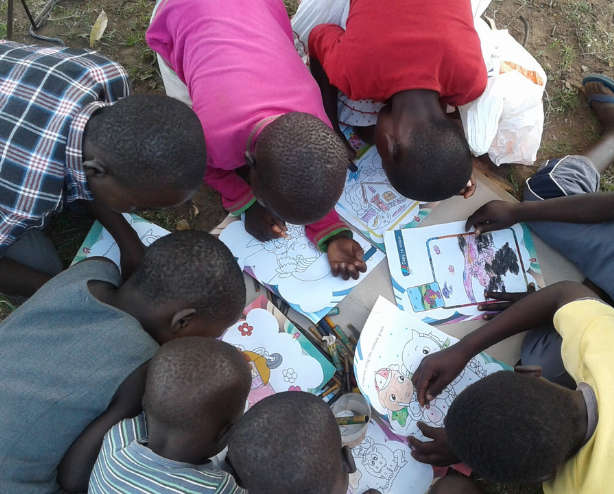
Preventing HIV and Transforming Lives
Since 2003, HJFMRI has successfully supported the U.S. President’s Emergency Plan for AIDS Relief ( PEPFAR ). Working with the U.S. Military HIV Research Program at WRAIR, the DoD and local partners in Africa, HJF has helped develop and implement comprehensive HIV prevention, care and treatment programs in Kenya, Nigeria, Tanzania and Uganda. These programs prevent HIV, save lives and strengthen global health security.
Conducting Research and Monitoring & Evaluation
Since 1979, CDC has worked with the Government of Kenya, other U.S. government agencies, and international donors to implement research in Kenya that has provided an evidence base for life-saving public health interventions, like insecticide treated bed nets, that are used around the world.

Child receiving vaccine in a clinic
Over the past 35 years, CDC has partnered with the Kenya Medical Research Institute (KEMRI) to build a comprehensive research platform, which includes research on HIV, tuberculosis (TB), malaria, emerging infections, neglected tropical diseases, and other public health issues. The platform is well equipped to test new diagnostics, vaccine candidates, and new treatment regimens.
One priority area is HIV research, which focuses on evaluating methods to prevent the spread of HIV and improve the health of persons living with HIV. CDC and KEMRI, leading the only research site in East Africa, participating in a multi-country study of discordant couples (a stable relationship in which one person is HIV-positive and the other is HIV-negative), contributed to the ground-breaking research that showed a 96 percent reduction in transmission of HIV to HIV-negative partners when the infected partner was on antiretroviral therapy. These results have influenced health policy and clinical practice in Kenya and around the world.
Each year, 1.5 to 2 million people worldwide die from TB disease. CDC and KEMRI are researching innovative ways of preventing, detecting, and treating TB among adults and children, including among people living with HIV for whom TB is one of the leading causes of death. One research project recently launched by CDC, KEMRI, the MOH, and the U.S. Agency for International Development will pilot three approaches to improving TB case detection, each of which is feasible in Kenya. Each approach will be piloted in separate areas and the change in case detection using each approach will be compared to the change in TB case detection in areas where no intervention was implemented. This will aid the Kenya MOH in identifying which strategy has the greatest population-level impact on TB case detection.
CDC and KEMRI’s long standing research collaborations and well established platforms are able to support complex vaccine research. In collaboration with key partners like Aeras and the Program for Appropriate Technologies for Health (PATH) Malaria Vaccine Initiative, research to test an improved TB vaccine and malaria vaccine candidate is in the advanced stages. Following a safety and efficacy study, the research will determine the most effective dose for infants for the improved and modern vaccine. This gold standard clinical trial is the first of its kind in over 80 years.
CDC and KEMRI, in partnership with the Ministry of Health and PATH, are also conducting a trial for a malaria vaccine candidate. The study is being carried out in three sites in Kenya and six other countries in sub-Saharan Africa. Thus far, this malaria vaccine is 55.8 percent effective in reducing the frequency of clinical and severe malaria in children 5-17 months.
Additionally, CDC and KEMRI’s research focuses on neglected tropical diseases (NTDs) to better understand the immunology, prevalence, and geographic distribution as well as to study the impact of NTDs in persons co-infected with HIV, TB, or other diseases. As a result, CDC Kenya and partners are able to develop more effective prevention and control strategies.
Program Evaluation
Through the U.S. President’s Emergency Plan for AIDS Relief (PEPFAR), CDC Kenya reduces the impact of the HIV epidemic by supporting HIV prevention services – such as HIV testing and counseling, youth risk reduction, and prevention of mother-to-child transmission – as well as care and treatment services for people living with HIV. CDC Kenya studies how these HIV services are implemented and their impact; evaluates best practices to determine what needs to be improved; and determines when effective activities should be scaled-up. Program evaluation activities include analyses of program impact, efficiency, and cost effectiveness to guide future program planning and decision-making.
Get CDC’s free global health newsletter each week! Enter your email address:
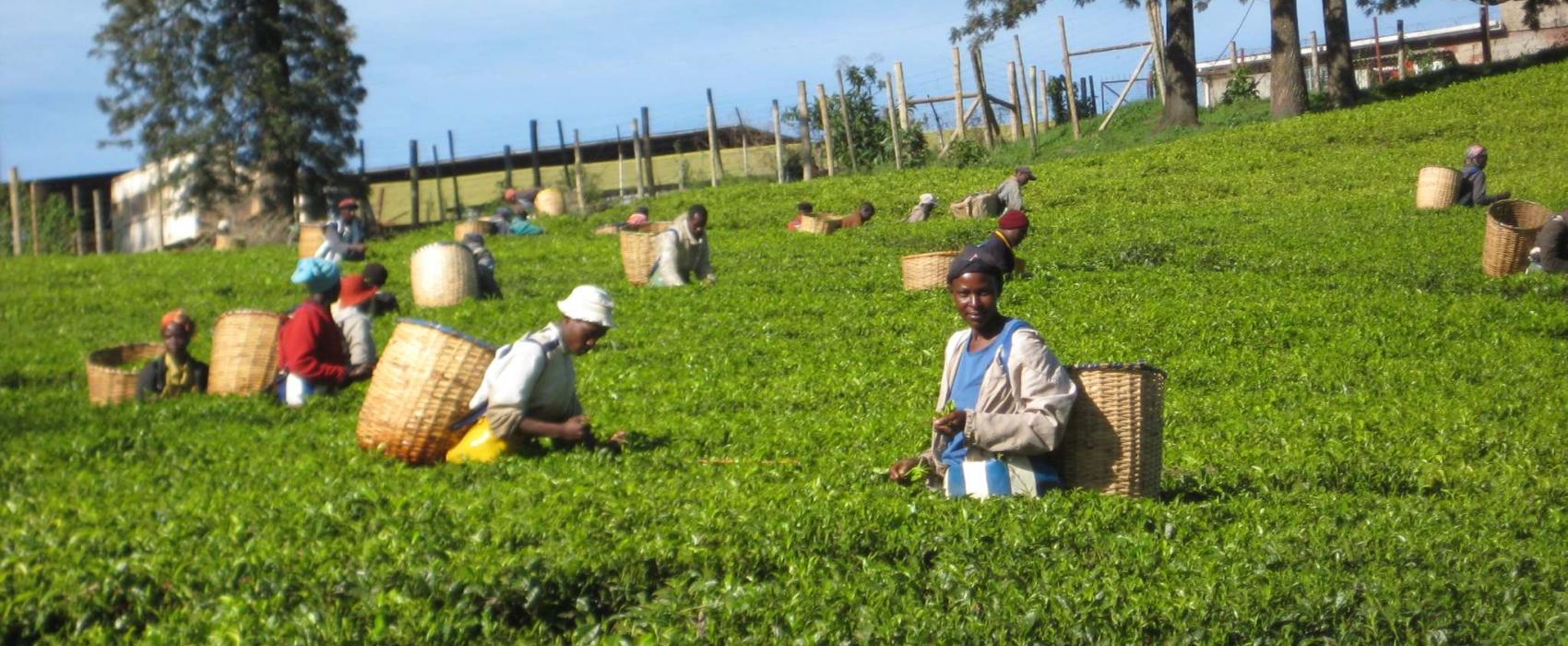
Kenya Research
In 1999, MHRP launched an international HIV vaccine research program in collaboration with the Kenya Medical Research Institute ( KEMRI) based in Kericho, Kenya. The program has developed expertise and infrastructure to support HIV vaccine, therapeutic and other infectious disease research. MHRP also works with a KEMRI satellite clinic, the Kombewa Clinical Research Centre, in Kisumu County. These programs are known locally as the Walter Reed Program-Kenya. The Moi University Clinical Research Centre in Eldoret is also part of MHRP's NIH-funded Clinical Trials Unit.
Kericho Clinical Research Center
The KEMRI Walter Reed Project Clinical Research Center, which opened in Kericho 2012, has successfully conducted more than 52 studies, ranging from clinical trials of therapeutics and vaccines to cohort studies. The Kericho CRC is part of MHRP’s NIAID Clinical Trials Unit networks, and maintains the high caliber standards and accreditations required for those activities:
- AIDS Clinical Trials Group ( ACTG )
- International Maternal, Pediatric, Adolescent, AIDS Clinical Trials ( IMPAACT ) Network
- HIV Vaccine Trials Network ( HVTN )
- COVID-19 Prevention Network ( CoVPN )
HIV Vaccine Research
The CRC has conducted three HIV vaccine trials and an HIV vaccine trial, RV460, completed vaccination in 2023 and analysis is ongoing. This was a randomized, double blind comparative adjuvant study for a DNA/ Protein Prime/Boost HIV Vaccine using gp145, which was developed by MHRP. One of the adjuvants being evaluated in this study is the MHRP-created ALF product .
Therapeutic studies have also been conducted at the CRC related to HIV/AIDS care and treatment and associated opportunistic infections such as tuberculosis, malignancies (Kaposi’s sarcoma) and malaria.
Cohort Studies
Over a period of nearly 10 years (2009-2018), the CRC carried out a large prospective acute infection cohort study, RV217 . The Kericho site enrolled more than 900 volunteers in the study for twice-weekly blood collections with 34 incident acute HIV infections observed. The high rate of volunteer visit compliance was key to study success.
Kericho continues to support the PEPFAR-funded African Cohort Study (AFRICOS) , a 15-year cohort longitudinal study that evaluates the impact of clinical, biological and socio-behavioral issues on HIV infection and disease progression. The Kericho site is also an implementer of the PEPFAR program in the region, so the surrounding community is assured access to HIV care, including antiretroviral therapy. The MOCHI cohort study began in 2022.
Other Infectious Diseases Research
The site has also conducted Ebola and polio vaccine trials. Additionally, the site has one Shigella vaccine trial in review, with two others under development. Plans for a yellow fever vaccine trial and a COVID-19 vaccine trial are also in the works.
Kombewa Clinical Research Centre, Kisumu
A KEMRI satellite clinic, the Kombewa Clinical Research Centre in Kisumu County participates in the African Cohort Study and other PEPFAR-supported research for the optimization of HIV prevention and treatment services. Current public health research is being conducted in collaboration with the Kenya Defense Force to investigate factors associated with virologic suppression and drug resistance in HIV positive children and adolescents on ART in Kenya (RV518).
Previously, Kisumu sites also participated in Phase 2 trials to assess a candidate Ebola vaccine regimen, Ad26.ZEBOV and/or MVA-BN-Filo.
Moi University Clinical Research Centre, Eldoret
Moi University Clinical Research Centre (MUCRC) is located at Moi Teaching and Referral Hospital (MTRH), Eldoret, Kenya. MRHP has worked with the site since 2008, the same year it was selected as a Clinical Research Site for the AIDS Clinical Trials Group (ACTG) Network. As part of that network, the site's work with MHRP is primarily in the area of HIV therapeutics and co-morbidity research.
WRAIR-Africa
The U.S. Department of Defense has conducted research in Kenya at the invitation of the Kenyan government since 1969. All MRHP activities in Kenya are conducted under the WRAIR-Africa, which is on the campus of the Kenyan Medical Research Institute (KEMRI) in Nairobi.
Global site navigation
- Celebrity biographies
- Messages - Wishes - Quotes
- TV and Movies
- Fashion and style
- Music and singers
- Capital Market
- Celebrities
- Relationships
Local editions
- Habari za Kenya Swahili
KEMRI contacts and branches
Kenya Medical Research Institute (KEMRI) is the national body in Kenya that carries out health research in the country. It was established in the year 1979 through the Science and Technology Act. Despite it being a prestigious organisation, most people hit a snag when trying to find the KEMRI Kenya contacts. If you are wondering how best to reach them, you are in the right place. Read on to know the KEMRI contacts and if their services are what you require.
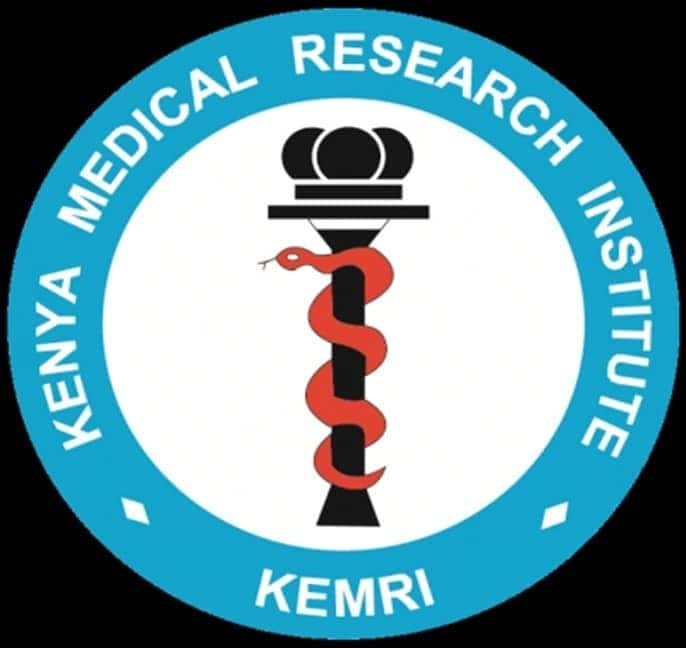
READ ALSO: Nairobi Hospital contacts and branches.
How to contact KEMRI
KEMRI has a total of three main branches across Kenya. These are in Nairobi, Kisumu and Mombasa. The Kemri branches contacts are listed below and can be confirmed in the official KEMRI website.
1.KEMRI Headquarters contacts (Nairobi)
Official Telephone number: +254 722205901
KEMRI Nairobi email contacts:
- DNA lab – [email protected]
- Infectious Parasitic Disease Research Program – [email protected]
- Centre for Clinical Research Laboratories – [email protected]
- Centre for Biotechnology Research and Development – [email protected]
- Centre for Traditional Medicine and Drug Development Programme – [email protected]
- Infectious Disease Research Training Program – [email protected]
- KEMRI Annual Scientific and Health Conference - [email protected]

Monarch Insurance Kenya contact and other details in 2022
2. KEMRI Mombasa
Telephone number for :
- Kwale: +254 721498846
- Kilifi:+254 721249977
3. KEMRI Kisumu
Physical Address: Off Kisumu-Busia Road, Kisumu.
Physical address of KEMRI headquarters
Head Office,
Woodley/ Kenyatta Golf Course,
Mbagathi road,
P.O BOX 54840-00200,
READ ALSO: Kemri internship application 2018-2019.
Functions and research programs of KEMRI
KEMRI plays a key role in the fight against diseases in Kenya as well as Sub-Saharan Africa as a whole. They carry out medical research in collaboration with other health organisations. These include the World Health Organisation (W.H.O), National Institute of medical research (Tanzania), Ethiopia Health and Nutrition Research Institute among many others.
The research findings are then translated by KEMRI into the formation and implementation of policies. KEMRI has achieved all this by having six research programs in the following areas:
- Public Health
- Infectious and parasitic diseases
- Biotechnology
- Non-communicable diseases
- Sexual, reproductive, child and adolescent health
- Natural products research and drug development

EACC services, physical address, contacts
That is not all, KEMRI also has their own line of products which they manufacture in their labs. For example, KEMRUB (hand sanitizer), TBcide (laboratory de-contaminant), KEMTAQ (DNA amplification kit) among others.
READ ALSO: Mater Hospital contacts and branches
Services offered by KEMRI
If you are wondering how KEMRI can be of service to you, here is how:
- Hiring or renting the institute’s facilities. KEMRI has hiring and renting services for their facilities. This is because their top-notch facilities are hard to come by.
- They offer incineration services. For the incineration of Biomedical waste, KEMRI has your back. Regardless of the type of waste, KEMRI is well equipped to handle its disposal.
- Diagnostic and pharmaceutical products. The KEMRI products undergo an efficient production process. There is quality control of the compounds used in production. This eliminates health risks.
- Routine and specialised diagnostic, clinical and analytical services. KEMRI does the clinical testing. It then offers an informed decision based on the findings.

Details of Mhasibu SACCO contacts, offices, PayBill, and deposit and loan accounts
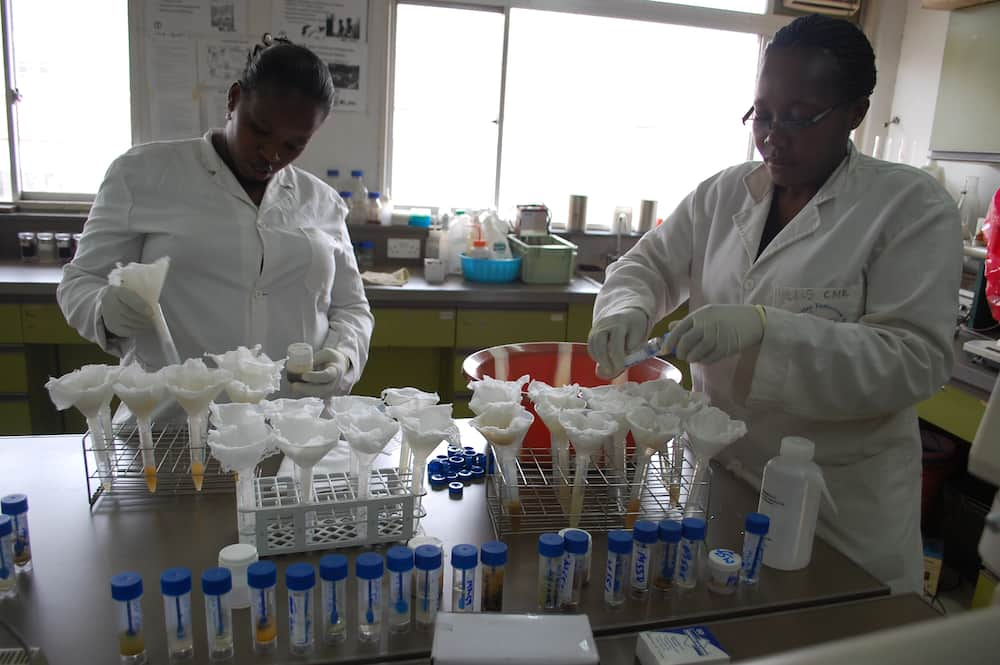
KEMRI is striving to its goal which is to be a leading centre of excellence in research for human health. Use the KEMRI contacts given above and get the help you require from them.
Source: TUKO.co.ke
Jackline Wangare (Lifestyle writer) Jackline Simwa is a content writer at Tuko.co.ke, where she has worked since mid-2021. She tackles diverse topics, including finance, entertainment, sports, and lifestyle. Previously, she worked at The Campanile at Kenyatta University. She has more than five years in writing. Jackline graduated with a Bachelor’s degree in Economics (2019) and a Diploma in Marketing (2015) from Kenyatta University. In 2023, Simwa finished the AFP course on Digital Investigation Techniques and Google News Initiative course in 2024. Email: [email protected].
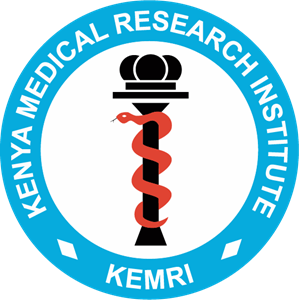
We'd love to hear from you
Thank you for your interest in the Kenya Medical Research Institute (KEMRI). If you have any questions, inquiries, or would like to learn more about our organization and the groundbreaking research we conduct in human health, please feel free to reach out to us using the contact information provided below.
Contact Information
Phone: +254 722 205901 / +254 (020) 2722541 Email: director obfsctd @kemri.go.ke
Alternatively, you can fill out the form provided, and our team will get back to you as soon as possible.
Note that our dedicated team is here to assist you and address any concerns you may have. We look forward to hearing from you and engaging in meaningful conversations about advancing healthcare and research in Kenya.
FIND US ON THE MAP

IMAGES
VIDEO
COMMENTS
The Kenya Medical Research Institute (KEMRI) is a State Corporation established in Kenya in 1979 through the Science and Technology (Repealed) Act, Cap 250 of the Laws of Kenya operated under the Science Technology and Innovation Act, 2013 as the national body responsible for carrying out research in human health in Kenya. Currently, KEMRI ...
Home - KEMRI. The KEMRI Wellcome Trust Research Programme is a. world-renowned health research unit of excellence. The programme was formed in 1989 when the Kenya Medical Research Institute formed a partnership with the Wellcome Trust and the University of Oxford. The Programme has grown from a small group of 12 to a state of the art facility ...
The Kenya Medical Research Institute (KEMRI) is a State Corporation established in Kenya in 1979 through the Science and Technology (Repealed) Act, Cap 250 of the Laws of Kenya operated under the Science Technology and Innovation Act, 2013 as the national body responsible for carrying out research in human health in Kenya. Currently, KEMRI ...
The Kenya Medical Research Institute (KEMRI) is a state corporation established through the Science and Technology (Amendment) Act of 1979, (since amended to the Sciences, Technology and Innovation Act 2013), during the tenure of Nicholas Biwott as Minister of State, [1] as the national body responsible for carrying out health research in Kenya.
The Kenyan Medical Research Institute (KEMRI) was established through the Science and Technology (Amendment) Act of 1979, which has since been amended to Science, Technology and Innovation Act, 2013 with the mandate to carry out health science research in Kenya. The Kilifi-based Centre for Geographic Medicine Coast (CGMR-C) is among the 12 ...
The Kenya Medical Research Institute is a medical research centre in East Africa. It is located in Kenya's capital, Nairobi. Established in 1979, KEMRI has played an important role in the fight against malaria, HIV/AIDS, and other diseases in Kenya and Sub-Saharan Africa as a whole
Kenya Medical Research Institute (KEMRI) is a State Corporation established through the Science and Technology (Amendment) Act of 1979, which has since been amended to Science, Technology and Innovation Act 2013. The 1979 Act established KEMRI as a National body responsible for carrying out health research in Kenya. Currently, KEMRI Operates ...
The Kenyan Medical Research Institute (KEMRI) was established through the Science and Technology (Amendment) Act of 1979, which has since been amended to Science, Technology and Innovation Act, 2013 with the mandate to carry out health science research in Kenya. The Kilifi-based Centre for Geographic Medicine Coast (CGMR-C) is among the 12 ...
The Kenya Medical Research Institute is a medical research centre in East Africa. It is located in Kenya's capital, Nairobi. Established in 1979, KEMRI has played an important role in the fight against malaria, HIV/AIDS, and other diseases in Kenya and Sub-Saharan Africa as a whole. View colors, shapes and information about the KEMRI logo.
Kenya Medical Research Institute logo Kenya Medical Research Institute logo Pulse Live Kenya. One such tale recounts how Asclepius brought a patient back from the brink of death using a herb shown to him by a serpent, reinforcing the snake's role as a benefactor in medicine.
Kenya Medical Research Institute, Nairobi, Kenya. 24,807 likes · 383 talking about this · 1,846 were here. Established in 1979, KEMRI is the national body mandated to carry out Human Health Research...
Reach us at Tel: 0722 205 901/020 272 254 1 or [email protected]. Kenya Medical Research Institute (KEMRI) is a State Corporation established through the Science and Technology (Amendment) Act of 1979, which has since been amended to Science, Technology and Innovation Act 2013. The 1979 Act established KEMRI as a National body responsible ...
Reacting to the announcement, the Kenya Medical Research Institute Director-General Elijah Songok expressed his gratitude to the Kemri fraternity. "First, I want to thank the Board of Directors for providing the institute with leadership; and second the members of staff for working tirelessly in ensuring the dissemination of health research ...
The KEMRI-Wellcome Trust Research Programme is a partnership between the Kenya Medical Research Institute, the Wellcome Trust and the University of Oxford. The Programme has grown from a small group to a facility hosting over 100 research scientists and 700 support staff working across Kenya, Uganda and the region.
Kenya Medical Research Institute (KEMRI) is a State Corporation established through the Science and Technology (Amendment) Act of 1979, which has since been amended to Science, Technology and ...
HJFMRI LTD GTE helped stand up a new Clinical Research Center in Abuja, Nigeria with the Walter Reed Army Institute of Research (WRAIR) to conduct clinical trials to combat infectious diseases. The CRC in Abuja conducts HIV studies and has pivoted to combat emerging health threats such as Ebola, Lassa fever and COVID-19. Since 2003, HJFMRI has ...
Kenya Medical Research Institute (KEMRI) is a State Corporation established through the Science and Technology (Amendment) Act of 1979, which has since been amended to Science, Technology and Innovation Act 2013. The 1979 Act established KEMRI as a National body responsible for carrying out health research in Kenya. Currently, KEMRI Operates ...
Conducting Research and Monitoring & Evaluation Since 1979, CDC and the Kenya Medical Research Institute (KEMRI) have worked together under a partnership called the KEMRI/CDC Research and Public Health Collaboration (KEMRI/CDC) providing an evidence base for interventions, like insecticide treated bed nets, used around the world.
In 1999, MHRP launched an international HIV vaccine research program in collaboration with the Kenya Medical Research Institute ( KEMRI) based in Kericho, Kenya. The program has developed expertise and infrastructure to support HIV vaccine, therapeutic and other infectious disease research. MHRP also works with a KEMRI satellite clinic, the ...
Kenya Medical Research Institute (KEMRI) is the national body in Kenya that carries out health research in the country. It was established in the year 1979 through the Science and Technology Act. Despite it being a prestigious organisation, most people hit a snag when trying to find the KEMRI Kenya contacts. If you are wondering how best to ...
Kenya Medical Research Institute (KEMRI) is a State Corporation established through the Science and Technology (Amendment) Act of 1979, which has since been amended to Science, Technology and Innovation Act 2013. The 1979 Act established KEMRI as a National body responsible for carrying out health research in Kenya. Currently, KEMRI Operates ...
Kenya Medical Research Institute (KEMRI) is a State Corporation established through the Science and Technology (Amendment) Act of 1979, which has since been amended to Science, Technology and Innovation Act 2013. The 1979 Act established KEMRI as a National body responsible for carrying out health research in Kenya. Currently, KEMRI Operates ...